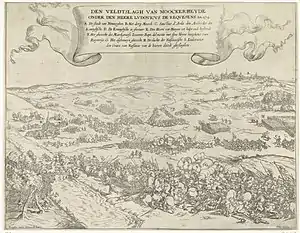Battle of Mookerheyde
In the Battle of Mookerheyde, Spanish forces defeated Dutch forces composed of German mercenaries on 14 April 1574 during the Eighty Years' War near the village Mook and the river Meuse not far from Nijmegen in Gelderland. Two leaders of the Dutch forces, brothers of William the Silent, were killed: Louis of Nassau (born 1538) and Henry of Nassau-Dillenburg (born 1550).[1]
| Battle of Mookerheyde | |||||||
|---|---|---|---|---|---|---|---|
| Part of the Eighty Years' War | |||||||
 | |||||||
| |||||||
| Belligerents | |||||||
|
German mercenaries |
| ||||||
| Commanders and leaders | |||||||
|
|
| ||||||
| Strength | |||||||
|
5,500 infantry 2,600 cavalry |
5,000 infantry 800 cavalry | ||||||
| Casualties and losses | |||||||
| 3,000 dead or wounded | 150 dead or wounded | ||||||
During the winter of 1573/74, Louis and Henry of Nassau raised a mercenary army in Germany of 6500 infantry and 3000 cavalry. They proceeded towards Maastricht to rendezvous with their elder brother William the Silent, Prince of Orange, who led 6000 Dutchmen. They planned to march their combined forces toward Leiden, which was under siege by a large Spanish force since October 1573.
The strength of Count Louis' forces diminished en route. More than a thousand men deserted and seven hundred were killed by the Spanish in a night attack. The remaining troops were mutinous because the Dutch had been unable to pay them. Louis crossed the Meuse with only 5,500 infantry and 2,600 cavalry. Before Louis could join forces with William, Luis de Requesens temporarily lifted the Siege of Leiden so that 5,000 infantry and 800 cavalry could counter Louis' advance. The Spanish army was led by Sancho d'Avila and Bernardino de Mendoza. The armies met near the village of Mook. Well timed attacks by the Spanish lancers destroyed the Dutch cavalry,[2] and the Spanish proved victorious.
The Dutch suffered a disastrous defeat, losing at least 3,000 men. The Dutch army of mercenaries, still not paid, soon dispersed. William long hoped that his brothers had been captured, but Louis and Henry were apparently killed and their bodies were never recovered.[3]
The Spanish then resumed the siege of Leiden, which failed when Dutch forces relieved the city in October.[4]
In the course of the battle, Spanish forces seized the command baton that William the Silent had given his brother Louis. The baton, long forgotten, was discovered at the Jesuit residence in San Cugat in Catalonia. In 2017, the General Superior of the Jesuits, Arturo Sosa, returned the baton to King Willem-Alexander of the Netherlands in a ceremony at the Vatican. The transfer was symbolic, in that ownership of the baton is retained by Catalonia as part of its cultural and historic patrimony.[5] The baton had passed to the Jesuits as part of the estate of Luis de Requesens, Governor General of the Spanish Netherlands in 1574. The Dutch plan to display it at the National Military Museum.[6][7]
References
- Arnade, Peter J. (2008). Beggars, Iconoclasts, and Civic Patriots: The Political Culture of the Dutch Revolt. Cornell University Press. pp. 240–1. Retrieved 26 June 2017.
- van der Hoeven, Marco, ed. (1997). Exercise of Arms: Warfare in the Netherlands, 1568-1648. Brill. p. 85.
- Harrison, Frederic (1902). The Life of William the Silent. A. L. Burt Company. p. 150.
- Putnam, Ruth (1911). William the Silent Price of Orange and the Revolt of the Netherlands. G.P. Putnam's Sons. pp. 281–6.
- Scaramuzzi, Iacopo (22 June 2017). "Il superiore dei Gesuiti 'restituisce' uno scettro al re olandese". La Stampa (in Italian). Retrieved 22 June 2017.
- "Koning ontvangt eeuwenoude bevelhebbersstaf". Telegraaf (in Dutch). 22 June 2017. Retrieved 22 June 2017.
- "Dutch royals return from Vatican with royal heirloom". Washington Post. Associated Press. 22 June 2017. Retrieved 26 June 2017.
- Additional sources
- Hans Delbrück, The Dawn of Modern Warfare: History of the Art of Warfare, Volume IV (University of Nebraska Press, 1990), 132ff.